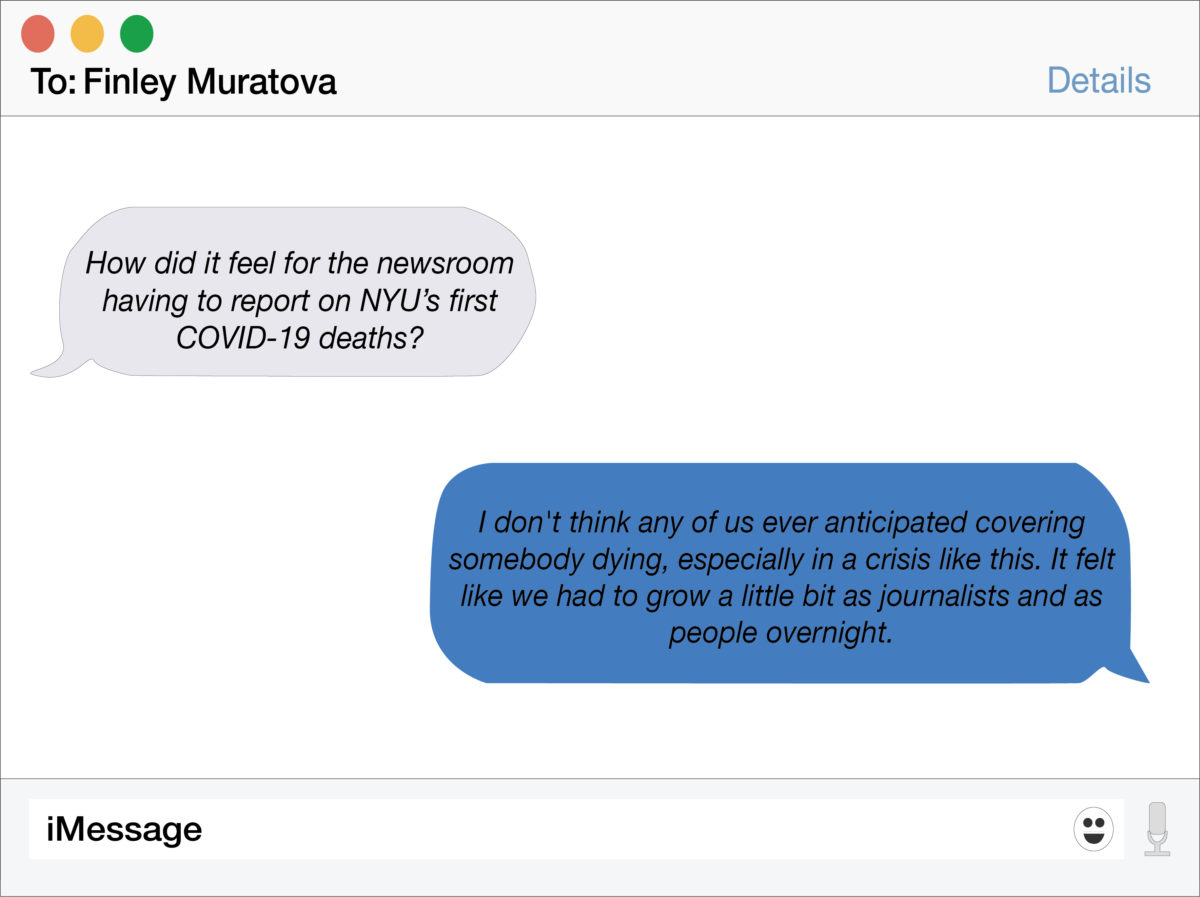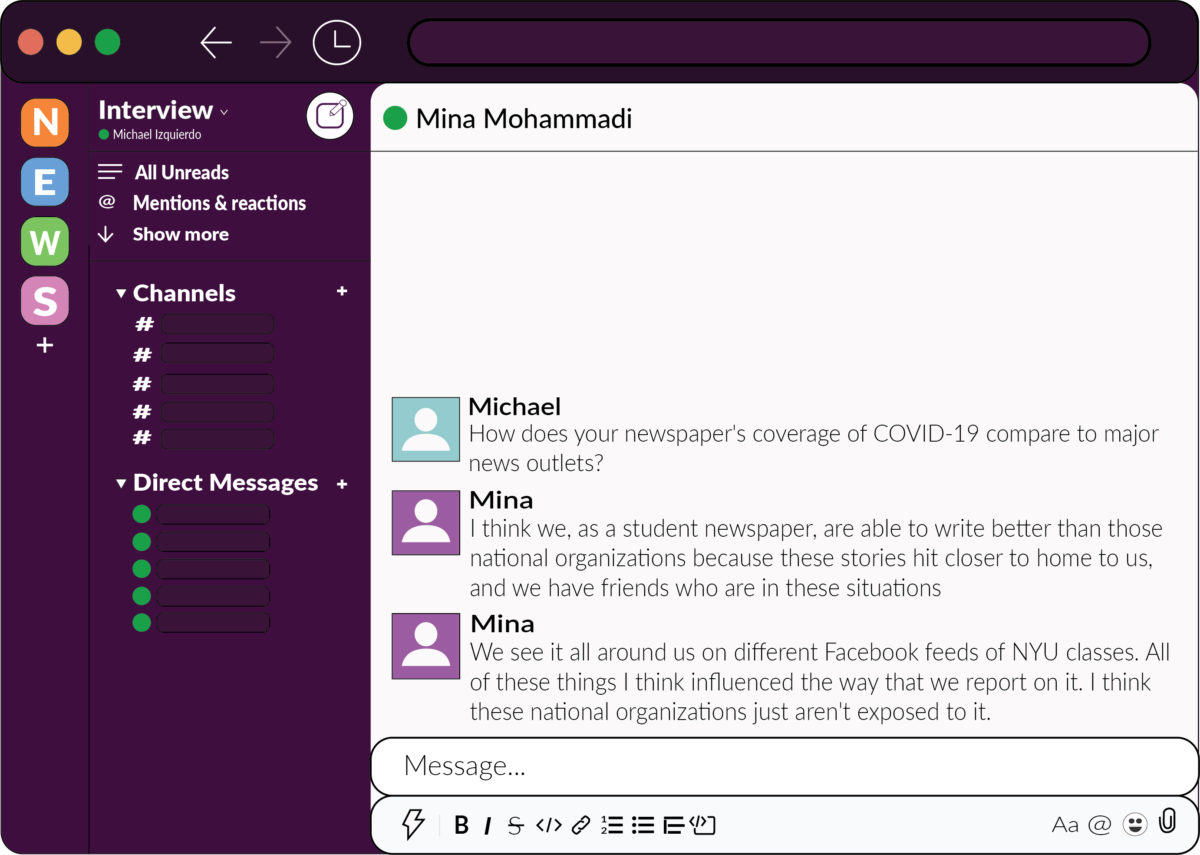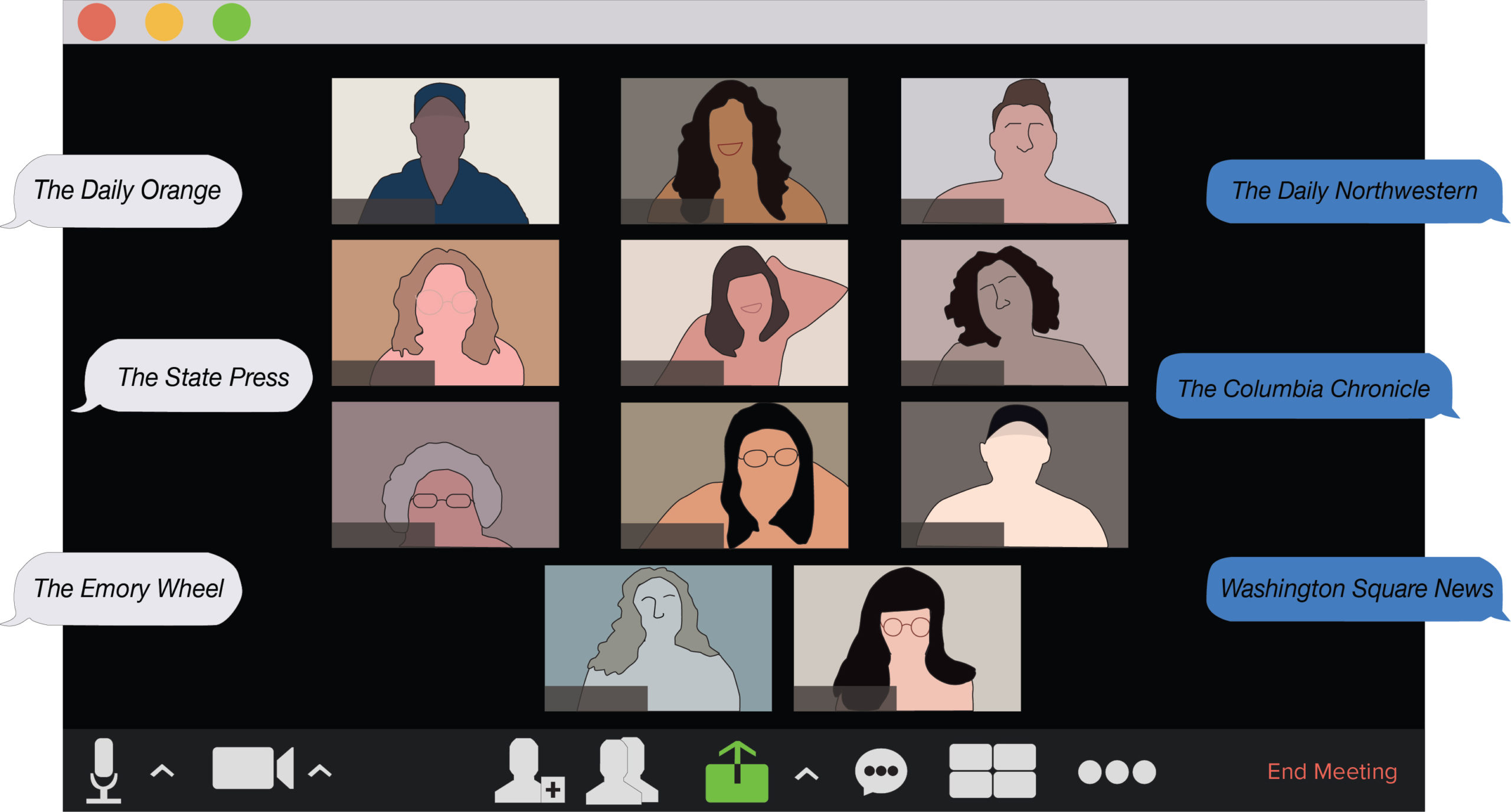Within the course of just a few days, Washington Square News, New York University’s student paper, reported on the school’s first COVID-19 deaths: Rodney Mack, a public safety officer, and Levester “LT” Thompson Jr., a former assistant women’s basketball coach.
Mack, 54, had worked at the university for 21 years, primarily at the College of Dentistry, before he died on April 5. Thompson Jr., 46, a graduate of NYU’s Stern School of Business, died on April 7.
These stories shocked the NYU newsroom. Despite not knowing these two individuals, none of the student journalists were prepared to write about the loss of human life. Most of the paper’s coverage focuses on students, administrative actions, and their impacts on the NYU community.
Finley Muratova, a deputy managing editor, said their stories usually focused on problems that can be solved, like updating grading policies and granting partial tuition refunds. However, the loss of a life is finite. “I don’t think any of us ever anticipated covering somebody dying, especially in a crisis like this,” said Muratova. “It felt like we had to grow a little bit as journalists and as people overnight.”
Student newspapers across the country have stepped up to report on the jarring realities their communities are grappling with during the pandemic. From coverage about online commencements and the risk of a Fall Semester on Zoom, to portraits of students’ struggling to live back home and protests for tuition refunds, these papers are at the forefront of documenting the present and future of their universities.
No longer content with major news outlets or their own university announcements, college newsrooms have taken control of the higher education narrative.
In-person communication has always been a key factor in these newsrooms, for tracking the progression of a story with reporters, receiving critiques, and managing how and when stories are published. These interactions help student journalists build close relationships and foster a community.
To replicate that in the social-distancing era, college newsrooms began creating iMessage group chats with other editors and reporters, using video conferencing apps like Zoom, and the workspace messaging platform Slack.
Washington Square News was overwhelmed with breaking news in the early days. “It was definitely a very immersive experience in terms of feeling what an actual newsroom would be like because we’re literally working 24/7,” said Muratova. “Our Slack channel was alive at like 4 a.m.”
Haley Robertson, the editor-in-chief at The Daily Orange, Syracuse University’s paper, said Slack had taken the place of daily meetings. The newsroom hosts weekly meetings on Zoom with the entire staff to stay connected and check in on one another.
Yet some editors and reporters have been overwhelmed keeping up with chats and Zooms.
“In the past, if I’m in the newsroom, I feel like I read every story or at least know about every story. Now, I feel like things get published. I didn’t even know because it’s hard to keep track of all these threads,” said print managing editor, Gabby Birenbaum, at The Daily Northwestern in Evanston, a suburb of Chicago. “If you go offline for a second, you might have missed something, and then I’ll also see something on Twitter and see if we reported on this, it turns out we actually did.”

While some newspapers chose to abandon print publication, outlets like Washington Square News, and Kentucky Kernel, the University of Kentucky’s student newspaper, have continued to publish their weekly print issues digitally through the online publishing platform, Issuu.
Other papers have put more emphasis on redesigning their website and producing special features. The Columbia Chronicle, Columbia College Chicago’s newspaper, sends daily newsletters containing a wrap up of all the stories posted that day.
The Daily Northwestern created a COVID-19 landing page, with tabs linking to stories around campus and within the greater Evanston area and a tips form to send or request information on COVID-19. Their editor-in-chief, Marissa Martinez, has been translating stories from English to Spanish. Because of these changes, the students have noticed more engagement on their website.
“At our peak, we were getting 42,000 pageviews on stories,” said Birenbaum. “I think we all felt a sense of purpose, and a sense of, ‘Oh, this is one of the times that having a campus newspaper is really important.’”
But, like most businesses, the pandemic has hurt student newspapers financially.
The Daily Orange generates substantial revenue from print sales and advertisements, but many of their advertisers are businesses on campus and are shut down.
“In some ways, we’re saving money because we’re saving print costs and delivery costs, “said editor-in-chief Haley Robertson,” But “we’re losing that advertising revenue.”
In an effort to hang on to ad revenue, The Daily Orange offered clients who purchased print advertising for March and April a discount in their special paper released on April 27, or an online advertisement spot on their website.
“We’ve seen a boost in digital ad purchase particularly for social media and our email blast. Although we do sell ads on our web page itself, we find that we gain a lot more traction through social media and things like that,” Robertson said.
Similarly, students at The Daily Northwestern have focused on digital advertising by creating a sponsored newsletter that goes out three times a week.
Currently, the paper is trying to boost their subscriptions in order to add another day, or create a specialized newsletter for their audience.
Increasingly, these newsletters contain stories found nowhere else.
Washington Square News, New York University’s paper, originally broke stories about COVID-19 back in January when deputy news editor Mina Mohammadi reported on the anxieties of New York University students at the Shanghai campus whose spring semester had been delayed.
“The article was about NYU Shanghai students who wanted to move their work to the NYU New York City campus because they were afraid of all that was going on, and they were afraid of going back home to the countries that they’re originally from,” she said.
Mainstream media outlets didn’t begin heavy coverage of the outbreak’s effect on universities in the United States until March, when colleges began to transition online and students traveled back home. The Washington Post reported on spring breakers traveling to Miami in the heat of the virus and the New York Times covered students witnessing class disparities at home via Zoom, among other topics.
But some young journalists are critical of mainstream media’s coverage of college students. They find their papers filling in the gaps, and say that communities are relying on them more than ever.
The Daily Northwestern has been able to report on how unionized graduate student workers are asking for an additional year of funding due to impacts from the pandemic. The newspaper has also done hyper-local coverage of the homeless population in Evanston, the work interfaith organizations have done to provide housing and takeout meals, and how the city is providing portable toilets and handwashing stations.
“We have a lot of trust in the Evanston community and we definitely feel that pressure to show up for them,” said Birenbaum. “We really feel a sense of mission, and urgency to do it. I think in that sense, it’s some of the best work we’ve ever done.”
Caroline Silva, a print managing editor at The Emory Wheel, reported on how doctors and other healthcare providers developed their own COVID-19 procedures at all Emory University hospitals. The story looked at how healthcare professionals compiled protocols and provided guidelines for doctors, and updated all workers about information received from the Centers for Disease Control and Prevention.
“I feel like national newspapers and local newspapers just aren’t able to contact those doctors and actually understand how their routine is being impacted,” Silva said.
Because they are part of the same university, she explains, college newsrooms have better access to the phone numbers and emails of experts within the institution.
Mina Mohammadi, at Washington Square News, said that she finds The Washington Post and The New York Times coverage of student experiences during pandemic vague and unconcentrated.
Students are having difficulty taking classes online, she said, but their troubles “extend way beyond that. It’s about students not getting their tuition back for the quality of the education they’re getting now. It’s about students who are now homeless because they don’t have anywhere to go.”
“I think we, as a student newspaper, are able to write better than those national organizations because these stories hit closer to home to us, and we have friends who are in these situations,” Mohammadi said. “We see it all around us on different Facebook feeds of NYU classes. All of these things I think influenced the way that we report on it. I think these national organizations just aren’t exposed to it.”
The young journalists have also remained fairly critical of their university’s COVID-19 announcements and emails. Their communications are vague, they say, and often leave the community more confused than before.
The papers have been the ones to connect the dots and provide accurate information to their audience.
At Washington Square News, reporters clarified multiple, university-wide emails about dorm evictions. They also provided a comprehensive list of resources available for students, and explained the impact of pass/fail policies.
From the beginning of the crisis, Mohammadi said, the administration wasn’t communicating clearly with the NYU community.
“There was a week where we got email after email after email of different updates that sometimes would repeat the same thing in one email, but then if you read just a little closer – there’s some new information,” she said. “It’s our job as journalists to basically take all these moving parts and bring them together in a fast enough manner where students feel they’re being informed.”
In some instances, Mohammadi said it’s hard to receive a statement from the NYU administration because they’re overwhelmed with work.
Mohammadi expressed that they’re persistent in their reporting because the paper serves the entire student body, across all campuses in New York City, Shanghai and Abu Dhabi.
Reporters at The Columbia Chronicle have also struggled with unclear administration missives. “When we’re reporting on those announcements, even the professors, the staff, the faculty at the college are confused, and they’re not sure what’s going on, they’re not sure what the administration is talking about or saying,” said managing editor Kendall Polidori.
“Oftentimes, we’ve been serving as that source of information to, not only students or families, but also people who work at the college who are just as confused as everybody is.”

College newsrooms initially responded to the outbreak with wall-to-wall COVID coverage. Other sections, like Arts & Culture or Sports, were pushed to the side.
But later, as newsrooms became acclimated to the virus, their reporting began to fill out, from album reviews and movies lists on Netflix, to quarantine recipes and local business creating masks, there’s no shortage of stories.
At The State Press, Arizona State University senior reporter Grace Lieberman and her staff covered the undergraduate student government (USG) elections, which began on March 30, despite the pandemic.
“It is a huge deal for people at ASU. There’s a lot of people who are either politically active who care about USG, or people who are really passionate about the university,” she said.
Sports reporters at The Daily Orange compiled anecdotes from Syracuse University’s alumni about their favorite sports moments from 1980 until now.
The Columbia Chronicle has begun a project documenting how students and professors from departments that require studio space are adjusting to online learning.
Music students have lost in-person performances and live ensembles. One photography student turned her laundry room into a dark room for her projects.. If a fashion student didn’t have a sewing machine back home, Columbia College Chicago mailed one.
“We found that a lot of the work is now on students, teaching themselves to do all of these things, rather than having a lot of instruction from professors or faculty,” said managing editor Kendal Polidori.
For other newsrooms, the impacts of the pandemic have highlighted where student newspapers have fallen short in their reporting.
At The Daily Northwestern, the team has an investigative desk, known as ‘In Focus,’ where they uncover stories related to education and equity within the community, among other topics.
“We’ve been doing a bunch of stories about work-study, student labor organizing, some really interesting stuff that I think now we’re building these relationships with sources that we can use in the future when this is over, and check in more regularly with those groups,” Gabby Birenbaum said. “Definitely, for me, it’s been like, ‘Oh, these are a bunch of groups we should have been covering more in the first place.’”
And these early-career journalists are battling not only the physical and mental exhaustion that normally accompanies being a student and a journalist but also the isolation and loneliness caused by social distancing.
Birenbaum, a Journalism and Political Science major, said that the newspaper is the most important part of her college experience and the source of most of her friends. Whether it was reporting on a story together or spending late nights putting together the print issue – all of that has been stripped away from her.
“That’s the hardest part for me. Not that we have to do the work, but the work is now separate from the fun aspect of it,” she said.
Since being quarantined, Birenbaum has been planning social events with other newspaper staff, like Netflix watch parties and bingo nights. She’s been trying to keep the newsroom community together.
Other journalists have had to remind themselves when it was appropriate to be engaged, and when it’s time to disconnect.
“I can come up with a million pitches, but I can’t do a million stories. I have to learn how to turn it off and delegate,” said Grace Lieberman at The State Press, who has given herself a curfew: No journalism-related work from 10 p.m. to 8 a.m. “When you’re passionate about something, it’s hard to give yourself breaks, but you’re going to burnout.” she said. That’s when she closes her computer and goes out to walk the dog.
For Finley Muratova, the pandemic has been tough journalistically and personally. Originally from Russia, they had to move when NYU closed its dorms during the first few days of spring break. Muratova couldn’t fly back home, it was too short notice and the risks of catching the virus were high. They had 48 hours to move out and find a new place to stay.
They found shelter in a friend’s apartment on Roosevelt Island. They had to take a total of twelve Uber trips between their dorm and the apartment, hauling their suitcases around and unpacking and repacking their belongings. And due to Muratova’s back issues and chronic fatigue, these trips took a physical toll on their body.
“I definitely have been struggling personally,” Muratova said. “I have diagnosed pretty severe medical OCD. This definitely doesn’t go well together with a pandemic. I think that it’s been particularly difficult with classes and maintaining deadlines,” they said. “At this point, I decided that what I’m most capable of right now is to choose one thing that is going to be my primary focus and roll with that.”
They chose the paper.







